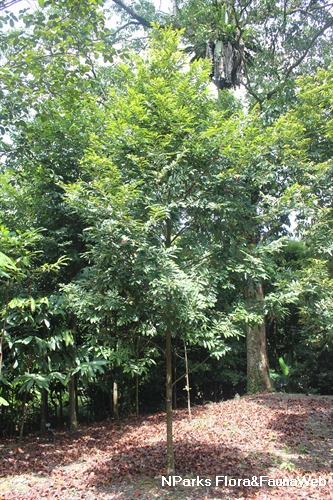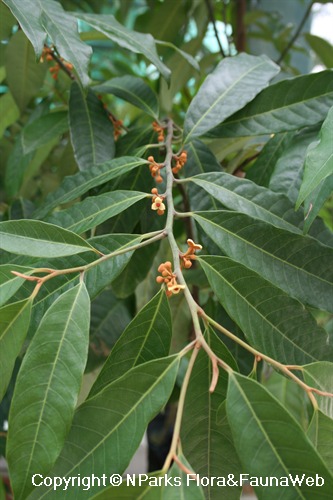
Back
Knema corticosa Lour.
| Family Name: | Myristicaceae |
| Synonyms: | Knema globularia (Lam.) Warb., Knema missionis (Wall. ex King) Warb. |
| Common Name: | Small-leaved Nutmeg, Gerahan, Merbatu Kechil, Penarahan Padi, Cendarah Padi, 小叶红光树 |
Knema corticosa or Small-leaved Nutmeg is a tree that grows to 24 m tall. It has membranous to thinly leathery leaves with a greyish underside. Both flowers and fruit are covered in rust-coloured, woolly hairs, the fruit is single-seeded enclosed within a rose-red aril.
Name
Classifications and Characteristics
| Plant Division | Angiosperms (Flowering Seed Plants) (Dicotyledon) |
|---|---|
| Plant Growth Form | Tree (Medium (16m-30m)) |
| Lifespan (in Singapore) | Perennial |
| Mode of Nutrition | Autotrophic |
| Plant Shape | Irregular |
| Maximum Height | 24 m |
Biogeography
| Native Distribution | Southern China, Myanmar, Vietnam, Laos, Thailand, Cambodia, Sumatra, Peninsular Malaysia, Singapore, Borneo, and Java |
|---|---|
| Native Habitat | Terrestrial (Primary Rainforest, Secondary Rainforest, Coastal Forest) |
| Preferred Climate Zone | Tropical, Sub-Tropical / Monsoonal |
| Local Conservation Status | Native to Singapore (Vulnerable (VU)) |
Description and Ethnobotany
| Growth Form | It is a tree that can grow up to 24 m tall. |
|---|---|
| Foliage | Leaves are membranous to thinly leathery, oblong to lance-shaped, dark metallic sheen above, greyish below. The leaves are covered in short hairs at the start, turn hairless (glabrous) with time. Leaves are measured 6 - 23 cm long by 1.3 - 7 cm wide. |
| Flowers | Flowers are dioecious where male or female flowers are produced on separate individuals. The male inflorescence has 5 - 20 flowers while female inflorescence bears fewer, up to 10. Each flower is greenish yellow, 3 - 4 lobed, up to 5 mm wide, covered in short, rust-coloured, woolly hairs. |
| Fruit | The fruit is held in clusters of up to 5. Each fruit is single-seeded, pinkish-orange, elliptic, almost round to pear-shaped. They measure between 1.2 - 2 cm long, 1 - 1.5 cm wide, grey-brown to rust-coloured hairs may be present. The seed is enclosed within a fleshy rose-red covering known as aril. |
| Habitat | Occurs in lowland primary forest, on low undulating land, swampy ground, hill sides in coastal forest, close to sandy beaches, to 250 m altitude. <1> |
| Associated Fauna | Its fruits are eaten by the Oriental Pied Hornbill (Anthracoceros albirostris). |
| Cultivation | It can be propagated by seed. |
| Ethnobotanical Uses | Timber & Products: Its wood can be used in house-building although not durable. |
Landscaping Features
| Desirable Plant Features | Ornamental Fruits |
|---|---|
| Landscape Uses | Coastal, General, Suitable for Roadsides, Parks & Gardens |
Fauna, Pollination and Dispersal
| Fauna Pollination Dispersal Associated Fauna | Bird-Attracting |
|---|---|
| Pollination Method(s) | Biotic (Fauna) |
| Seed or Spore Dispersal | Biotic (Fauna) |
Plant Care and Propagation
| Light Preference | Full Sun |
|---|---|
| Water Preference | Moderate Water |
| Plant Growth Rate | Slow |
| Rootzone Tolerance | Moist Soils, Well-Drained Soils, Saline Soils / Salt Spray, Fertile Loamy Soils |
| Maintenance Requirements | Moderate |
| Propagation Method | Seed |
Foliar
| Foliage Retention | Evergreen |
|---|---|
| Mature Foliage Colour(s) | Green |
| Mature Foliage Texture(s) | Leathery, Thin |
| Young Flush Texture(s) | Velvety / Furry / Tomentose |
| Foliar Type | Simple / Unifoliate |
| Foliar Arrangement Along Stem | Alternate |
| Foliar Attachment to Stem | Petiolate |
| Foliar Shape(s) | Non-Palm Foliage (Lanceolate, Oblong) |
| Foliar Venation | Pinnate / Net |
| Foliar Margin | Entire |
| Foliar Apex - Tip | Acuminate, Acute |
| Foliar Base | Cuneate, Rounded / Obtuse |
| Leaf Area Index (LAI) for Green Plot Ratio | 3.0 (Tree - Intermediate Canopy) |
| Mature Foliage Colour(s) Remarks | Greyish below. |
Non - Foliar and Storage
| Stem Type & Modification | Woody |
|---|---|
| Root Type | Underground (Tap Root) |
Floral (Angiosperm)
| Flower & Plant Sexuality | Unisexual Flowers , Dioecious |
| Flower Colour(s) | Cream / Off-White, Yellow / Golden |
|---|
| Flower Texture(s) | Velvety / Furry / Tomentose |
| Flower Grouping | Cluster / Inflorescence |
| Flower Location | Axillary |
| Flower Symmetry | Radial |
| Individual Flower Shape | Cruciform / Cross-shaped |
| Inflorescence Type | Umbel |
| Flowering Habit | Polycarpic |
Fruit, Seed and Spore
| Mature Fruit Colour(s) | Yellow / Golden |
|---|---|
| Mature Fruit Texture(s) | Velvety / Furry / Tomentose |
| Fruit Classification | Simple Fruit |
| Fruit Type | |
| Seed Quantity Per Fruit | Few (1-5) |
References
| References | <1> de Wilde, W.J.J.O. & Duyfjes, B.E.E. (2018). Knema. In: Kiew, R., Chung, R.C.K., Saw, L.G., Soepadmo, E. (2018). Myristicaceae. Flora of Peninsular Malaysia, ser. 2 Seed Plants, vol. 7, pp. 202-204. Kuala Lumpur: Forest Research Institute Malaysia. |
|---|
Image Repository
Others
| Master ID | 1689 |
|---|---|
| Species ID | 2982 |
| Flora Disclaimer | The information in this website has been compiled from reliable sources, such as reference works on medicinal plants. It is not a substitute for medical advice or treatment and NParks does not purport to provide any medical advice. Readers should always consult his/her physician before using or consuming a plant for medicinal purposes. |

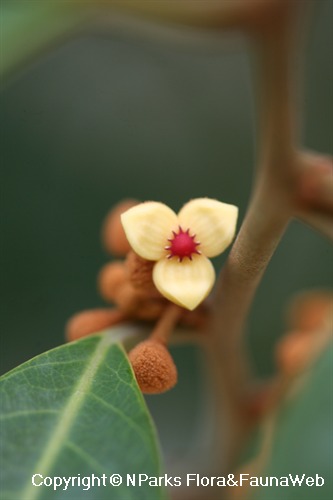
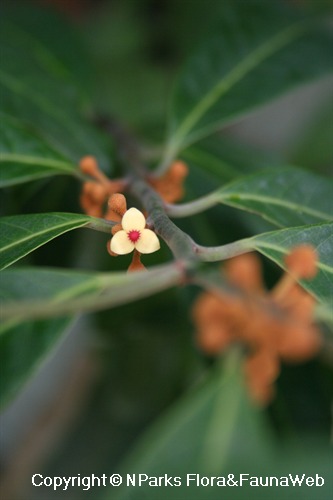
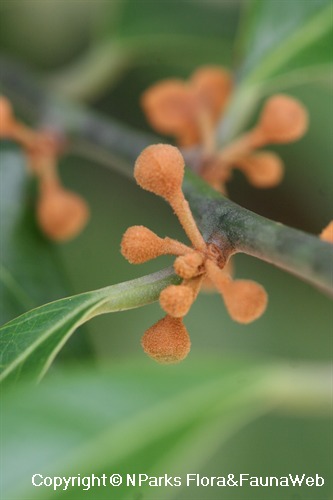
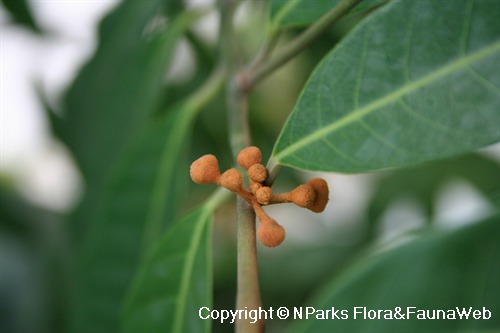
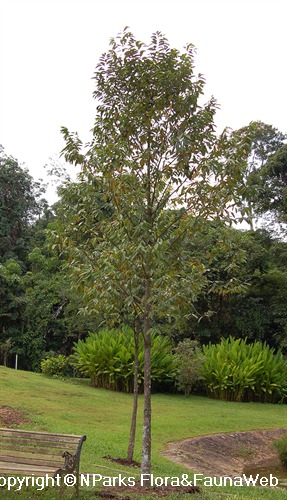
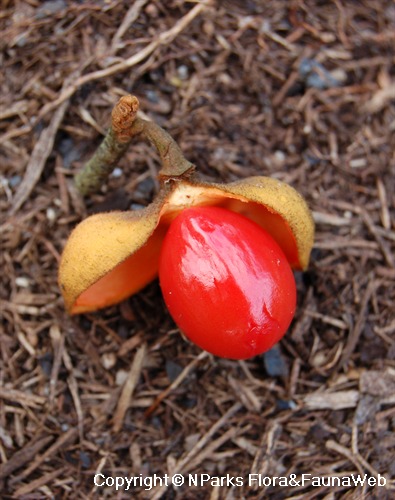
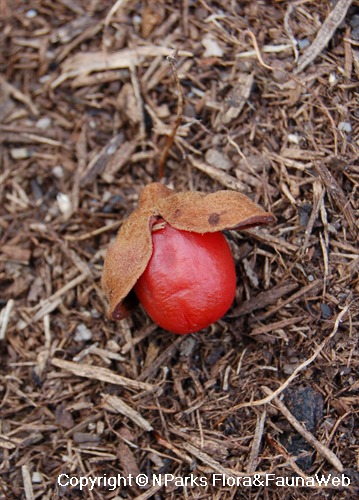
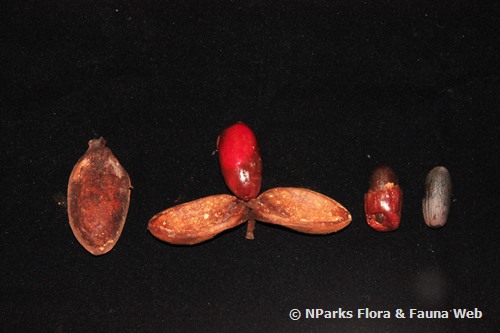
.jpg)
.jpg)
